
It’s 2021 and I feel like traveling! This year, however, for many reasons, I’ll only be traveling the world via my pancake passport. So let’s travel to France by making some crepes. We’ll also learn about the beginnings of the crepe and the history of La Chandeleur, the day of crepes celebration.
Brittany, France
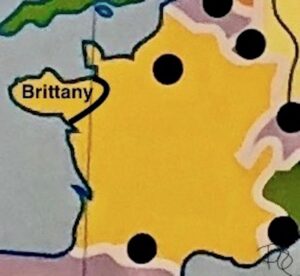
Brittany region of France
To celebrate February 2nd, La Chandeleur, the day of crepes, our first stop on this itinerary is Brittany, France, home of the world known, delectable crepe. The first crepe was actually made with buckwheat. Buckwheat was introduced into the Brittany region in the 13th century and the story goes that a housewife spilled her buckwheat porridge on a hot pan and, viola, created the crepe! Yet another happy accident in history!
Buckwheat
Buckwheat is not related to wheat and is a pseudo-cereal, a non-starchy gluten free food grain with a nutty flavor. Originally from China, it made its way to Europe via Turkey and Russia. It is a hardy grain able to thrive in areas (such as the wet Brittany, France) that are inhospitable to other grains.
Although buckwheat is gluten free on its own, be aware that many crepe recipes mix wheat flour with it to make the batter smoother and more workable. I kept our experiment as true to the original as possible using only buckwheat, eggs, salt and water. It proved to be a little challenging to get the correct consistency and the buckwheat crepe tends to crack more than those made with wheat flour.
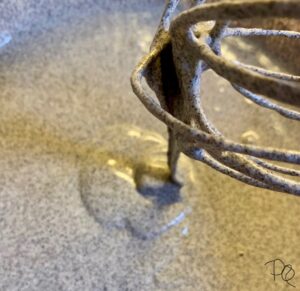
Buckwheat crepe batter
Traditionally, this crepe is served with ham, cheese and egg. We used gruyere cheese and it was delicious.
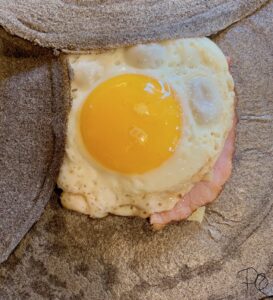
Buckwheat crepe with ham, gruyere and egg.
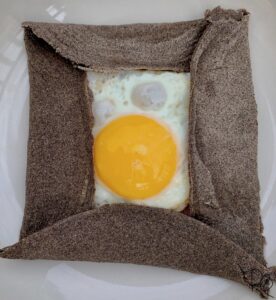
Folded buckwheat crepe
A little background of February 2nd
In the US and Canada, February 2nd is known as groundhog day, the day we find out whether the emerging groundhog sees its shadow or not to determine when spring is coming. Typically, a clear sunny day for the groundhog, or for the Christian festival Candlemas, or Candlemass, forebodes a prolonged winter. Earlier this date was associated with the Roman pagan celebration Lupercalia, a feast of purification, fertility of the earth and the end of winter.
Candlemas, feast of the purification of the Virgin Mary
February derives from the Latin word februa, meaning purification. In Roman history it is actually the 12th month in the year, named after the purification god Februus and designates the month to purification.
Candlemas comes 40 days after the nativity and is the day Mary, in accordance with Jewish law, went to the Temple in Jerusalem to both be purified after the birth of her son, Jesus, and to present Jesus to God as her firstborn. By the 5th century, observing the festival with lighted candles was introduced and gave way to its current name. Candles are seen as a symbol of Jesus, also known as the Light of the World. Now it is common for Christians to bring candles to church for blessing. The French name, La Chandeleur comes from the word chandelle meaning candle.
La Chandeleur, the Day of Crepes
La Chandeleur, Fête de la Lumière or Jour des crêpes, is widely celebrated in France with crepes. This tradition is said to have started in the 5th century with Pope Gelasius I, who started a candlelit procession around Rome and handed out galettes, a saltier dough-like crepe, to the pilgrims who came to Rome for the procession. This possibly came about to parallel the celebration of Lupercalia where vestal virgins made offerings of salted meal cakes. The crepes were also seen as a symbol of the sun with their golden color and round shape, indicating the end of winter.
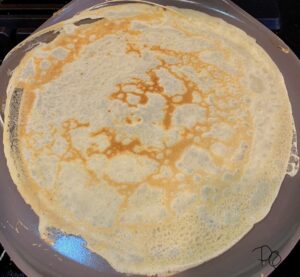
Round crepe, golden like the sun
La Chandeleur is also a day with some superstition as there is a bit of fortune-telling while making the crepes. Traditionally, one is to hold a coin in one hand or writing hand and flip a crepe in the pan with the other hand. If the crepe flips and is caught into the pan, then your family will supposedly be prosperous for the rest of the year. If you drop it, then the opposite. There is even some evidence that Napoleon attributed his misfortune in Moscow to the 5th crepe lost to the floor.
My La Chandeleur
There are so many different types of crepes to be made. After our buckwheat crepes with ham, cheese and egg, we moved on to sweeter dessert crepes made with wheat flour. It is a much runnier batter and easier to work with on the pan.
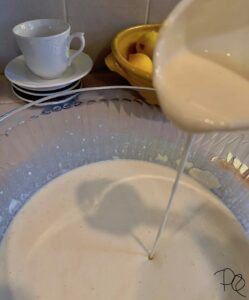
Thin wheat batter
I chose to make crepes with the toppings and fillings I had encountered when I was in Paris years ago and frequently stopped at the street vendor creperies. These included nutella with bananas, simple lemon juice and powdered sugar and just plain fruit.
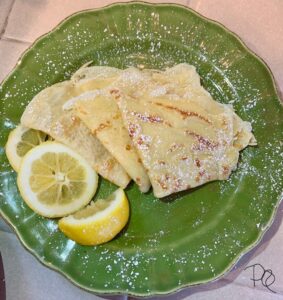
Folded lemon crepes

Three of my favorite crepes
For this occasion, I did buy a special crepe pan, spreader and spatula. This non-stick pan allows for minimal to no butter needed and is still easy to flip. I’m not sure what the superstition means if you catch your crepe halfway off, but that happened to me many times.

Crepe pan, spreader and spatula
For fun, I did make a few in a regular non-stick frying pan with butter and it still works well with just a swirl technique to spread the batter. Using a cast iron would also work if you are looking for a workout as well.
As I couldn’t find Nutella after shopping at a couple of stores, I found two pleasant substitutions. Whole foods has a great version which tastes like the original. I also found a dairy free, gluten free Nocciolata which has a more dark chocolatey taste. Both are palm oil free as well and I highly recommend giving them a try.

365 hazelnut cocoa spread and Nocciolata dairy and gluten free hazelnut cocoa spread
There are a ton of recipes online and in cookbooks for crepes. My recommendation is to keep it simple and keep it fun. Although I appreciate the progression of recipes and techniques, remember that in the 13th century there were no refrigerators, blenders or special pans so most anyone can find a way to make crepes.
That’s all for now. Hope you enjoy La Chandeleur!

